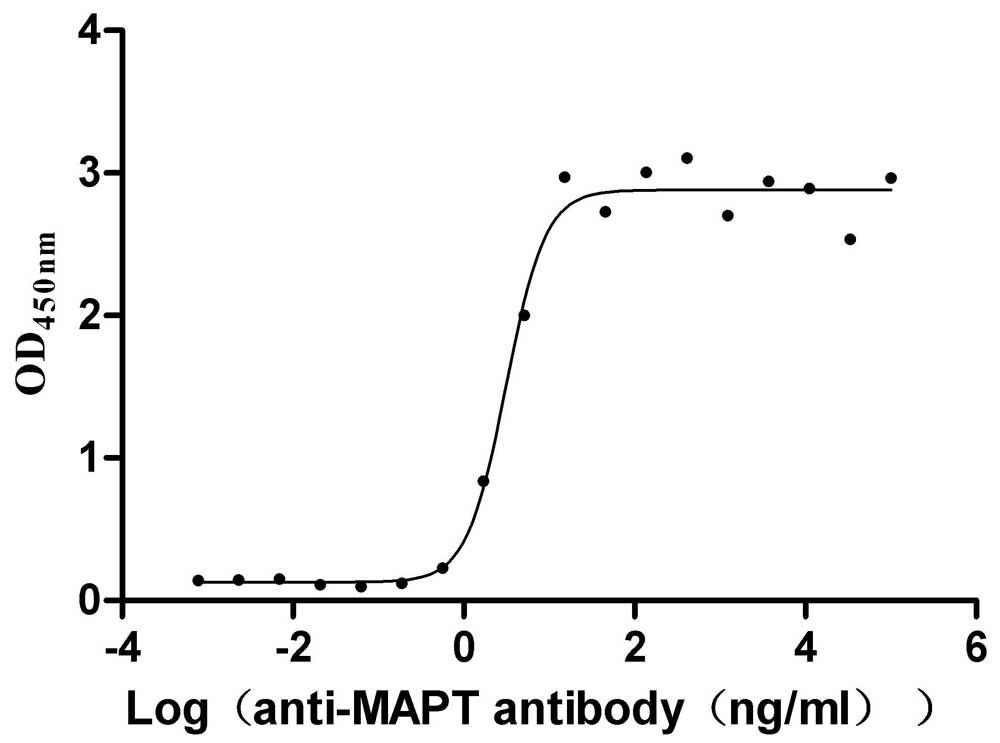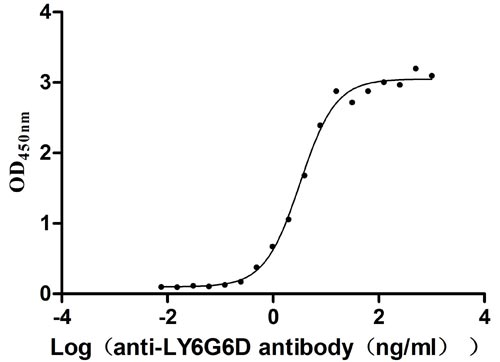Recombinant Rat Aquaporin-2 (Aqp2)
In Stock Promotion-
中文名稱:
-
貨號(hào):CSB-CF001962RA
-
規(guī)格:¥9720
-
促銷:
-
圖片:
-
其他:
產(chǎn)品詳情
-
純度:Greater than 85% as determined by SDS-PAGE.
-
基因名:Aqp2
-
Uniprot No.:
-
種屬:Rattus norvegicus (Rat)
-
蛋白長度:Full Length
-
來源:in vitro E.coli expression system
-
分子量:30.4 kDa
-
表達(dá)區(qū)域:1-271aa
-
氨基酸序列MWELRSIAFSRAVLAEFLATLLFVFFGLGSALQWASSPPSVLQIAVAFGLGIGILVQALGHVSGAHINPAVTVACLVGCHVSFLRAAFYVAAQLLGAVAGAAILHEITPVEIRGDLAVNALHNNATAGQAVTVELFLTMQLVLCIFASTDERRGDNLGSPALSIGFSVTLGHLLGIYFTGCSMNPARSLAPAVVTGKFDDHWVFWIGPLVGAIIGSLLYNYLLFPSAKSLQERLAVLKGLEPDTDWEEREVRRRQSVELHSPQSLPRGSKA
Note: The complete sequence including tag sequence, target protein sequence and linker sequence could be provided upon request. -
蛋白標(biāo)簽:N-terminal 10xHis-tagged
-
產(chǎn)品提供形式:Liquid or Lyophilized powder
Note: We will preferentially ship the format that we have in stock, however, if you have any special requirement for the format, please remark your requirement when placing the order, we will prepare according to your demand. -
緩沖液:If the delivery form is liquid, the default storage buffer is Tris/PBS-based buffer, 5%-50% glycerol. If the delivery form is lyophilized powder, the buffer before lyophilization is Tris/PBS-based buffer, 6% Trehalose.
-
復(fù)溶:We recommend that this vial be briefly centrifuged prior to opening to bring the contents to the bottom. Please reconstitute protein in deionized sterile water to a concentration of 0.1-1.0 mg/mL.We recommend to add 5-50% of glycerol (final concentration) and aliquot for long-term storage at -20℃/-80℃. Our default final concentration of glycerol is 50%. Customers could use it as reference.
-
儲(chǔ)存條件:Store at -20°C/-80°C upon receipt, aliquoting is necessary for mutiple use. Avoid repeated freeze-thaw cycles.
-
保質(zhì)期:The shelf life is related to many factors, storage state, buffer ingredients, storage temperature and the stability of the protein itself.
Generally, the shelf life of liquid form is 6 months at -20°C/-80°C. The shelf life of lyophilized form is 12 months at -20°C/-80°C. -
貨期:3-7 business days
-
注意事項(xiàng):Repeated freezing and thawing is not recommended. Store working aliquots at 4°C for up to one week.
-
Datasheet & COA:Please contact us to get it.
相關(guān)產(chǎn)品
靶點(diǎn)詳情
-
功能:Forms a water-specific channel that provides the plasma membranes of renal collecting duct with high permeability to water, thereby permitting water to move in the direction of an osmotic gradient. Plays an essential role in renal water homeostasis.
-
基因功能參考文獻(xiàn):
- AQP2 is crucial for the activation of SK3 by TRPV4, leading to hyperpolarization of the plasma membrane. PMID: 29243846
- AQP2 expression is markedly increased in kidneys following chronic stress. PMID: 30021346
- Low AQP2 expression is associated with hypertension. PMID: 30009821
- ezrin facilitates AQP2 endocytosis, thus linking the dynamic actin cytoskeleton network with AQP2 trafficking. PMID: 28754689
- Results provide evidence that NHE2 and AQP2 work in coordination as part of the cellular device that regulates collecting duct cell cycle progression. PMID: 27191152
- The results of this study using multiple approaches and 2 different animal models of hypercalcemia revealed that autophagic degradation of a specific set of proteins including AQP2 was observed at the early onset of nephrogenic diabetes insipidus. PMID: 28139295
- PP2C activity is required for S261 AQP2 dephosphorylation upon vasopressin stimulation, which occurs independently of S256 phosphorylation. PMID: 28381458
- aquaporin-2 regulates serine/threonine phosphatases in renal collecting duct PMID: 27784696
- These results suggest that Ser-261 phospho-regulation is involved in pS256- and pS269-mediated AQP2 apical translocation. PMID: 28668390
- These results provide the direct evidence that the Ser-261 dephosphorylation is involved in the pS256- and pS269-related AQP2 regulation. PMID: 27889609
- Upregulation of AQP-2 in the distal colon is found in cirrhotic rats with ascites. Tolvaptan inhibits its expression and may decrease water reabsorption and induce diarrhea. PMID: 27022218
- Data show that enhanced autophagic degradation of proteins, most notably including aquaporin-2 (AQP2), is an early event in hypokalemia-induced nephrogenic diabetes insipidus (NDI). PMID: 26674602
- Remote ischemic perconditioning prevents dysregulation of renal water and salt handling via regulation of AQP2 expression and phosphorylation as well as via regulation of Na-K-ATPase expression in I/R rat kidneys. PMID: 27405971
- the activation of CaSR in the collecting duct prevents the cyclic AMP-dependent increase in AQP2-phosphorylation at S256 and water permeability, counteracting the short-term vasopressin response. PMID: 25977473
- Therefore, we suggest that there is a regional heterogeneity of regulation of renal NPRs, TonEBP, and APQ-2 mRNA in acute kidney injury . PMID: 25858778
- increased expression in facial nerve following crush injury PMID: 25762220
- AVP-induced increase in AQP2 is blunted in heart failure during cardiac remodeling and is associated with decreased AT1R abundance in rat kidney. PMID: 25658446
- Suggest ERalpha in mediates the inhibitory effect of estradiol on AQP2 expression in collecting ducts. PMID: 26062878
- Exercise training decreased AQP-2 and beta-tubulin protein expression. PMID: 21251048
- The direct renin inhibitor aliskiren increased water channel AQP2 expression in obstructed kidneys of UUO mice, at least partially by preventing NLRP3 inflammasome activation in association with ureteral obstruction. PMID: 25694485
- Reduced activity of PP2A, secondary to reduced intracellular Ca2+ levels, promotes AQP2 trafficking independently of the arginine vasopressin-protein kinase A axis. PMID: 24700872
- Developed a systematic procedure for identifying new compounds that modulate AQP2 trafficking using high throughput screening, in vitro assays in cells/kidney slices, and in vivo testing in an animal model. PMID: 24944200
- The data demonstrate that VACM-1 is involved in the regulation of AQP2 protein concentration and may play a role in regulating water balance. PMID: 23171819
- It is a water channel and its abnormal gene expression in kidney causes a disorder of urine concentrating ability. PMID: 24531898
- These data suggest that an increased plasma level of vasopressin promoted the excretion of urinary exosomal AQP2 and that urine alkalinization also increased it independently of vasopressin. PMID: 23986519
- Hypothyroidism contributes in a differential way to aging-induced changes in renal function, and medullary NO and AQP2 would be implicated in maintaining water homeostasis. PMID: 23706747
- An increase in cell proliferation is observed in renal cells expressing AQP2. PMID: 22786728
- Antidiuretic hormone might play an important role in controlling the expression of AQP-2 in the endolymphatic sac and kidney. PMID: 15338864
- Emodin can inhibit the genetic transcription and translation of AQP2 gene in NRK cells. PMID: 21038660
- Protein expression of AQP2 was significantly lower after ovariectomy and was restored to the control levels after 17beta-estradiol treatment. This suggests that AQPs may have a role in detrusor overactivity that occurs with hormonal alteration in female rat. PMID: 21479884
- Our data provide evidence of a novel association between TRPV4 and AQP2 that is involved in the activation of TRPV4 by hypotonicity and regulation of cellular response to the osmotic stress PMID: 21938744
- Report age-related changes in expression of renal AQP2 in response to congenital, partial, unilateral ureteral obstruction in rats. PMID: 22028046
- Report AQP2 up-regulation in the solitary kidney in response to partial ureteral obstruction in neonatal rats. PMID: 21677414
- Data suggest that EP2 and EP4 agonists increase AQP2 phosphorylation and trafficking, likely through different signaling pathways. PMID: 21768374
- Simvastatin -induced membrane accumulation of AQP2 in cultured cells and kidney slices in vitro is mainly due to reduced endocytosis rather than increased exocytosis. PMID: 21511701
- downregulation of AQP2 could in part be caused by degradation of AQP2 through a lysosomal degradation pathway PMID: 21525134
- AQP2 was mainly localized to the type II, IV, and V fibrocyte of the spiral ligament of the inner ear. Interaction between AQP1, AQP2 and AF might be possible. PMID: 17628981
- KCC1 affects water transport solely by K(+) extrusion. Intracellular K(+) retention conceivably leads to cell swelling, followed by an increased rate of endocytic AQP2 retrieval from the apical membrane. PMID: 21112289
- Elevation of cAMP increased AQP2 protein levels within 30 minutes in primary inner medullary collecting duct cells. PMID: 20724536
- AQP2 expression facilitates cell swelling or shrinkage leading to the activation of channels necessary to the control of cell proliferatio and apoptosis. PMID: 20432437
- Upregulation of AQP2 expression is maintained dependent upon non-suppressible release of arginine vasopressin in rats with glucocorticoid deficiency. AQP2 plays a crucial role in impairment of water excretion in aged rats with glucocorticoid deficiency. PMID: 19040709
- These results demonstrate that NSAIDs decrease AQP2 protein abundance, particularly during adaptation during dehydration. PMID: 20130117
- The results indicate that COX-2 inhibition does not mimic ANG II receptor (AT1R) blockade-mediated effects and that AT1R-mediated AQP2 regulation in the postobstructed kidney collecting duct is independent of COX-2 induction. PMID: 20107111
- These studies suggest that Ser269 phosphorylation may be a more consistent indicator of vasopressin action and AQP2 membrane abundance than is Ser256 phosphorylation. PMID: 20089674
- delineates induction and degradation mechanisms of AQP2 endogenously expressed by a renal collecting duct principal cell line PMID: 11782489
- Aquaporin-2 transcription is differentially regulated by dietary salt in Sprague-Dawley and Dahl SS/Jr rats PMID: 12176047
- by elevated effective osmolality (tonicity) is crucial for the expression of AQP2 in inner medullary cells of the kidney PMID: 12388395
- AQP2-bearing vesicles are a unique intracellular compartment distinct from the endoplasmic reticulum, Golgi apparatus, trans-Golgi network and lysosome. Endosomes might be involved in the trafficking of AQP2. PMID: 12422412
- cAMP initiates an early step, namely the transport of AQP2-bearing vesicles towards the plasma membrane. The data do not support a regulatory function for Ca(2+) in the AQP2 shuttle. PMID: 12524527
- The expression of the collecting duct water channel AQP2, p-AQP2 and AQP3 was significantly downregulated after hemorrhagic shock (HS), which may play an important role in the impaired urinary concentrating ability in HS-induced acute renal failure. PMID: 14605277
顯示更多
收起更多
-
亞細(xì)胞定位:Apical cell membrane; Multi-pass membrane protein. Basolateral cell membrane; Multi-pass membrane protein. Cell membrane; Multi-pass membrane protein. Cytoplasmic vesicle membrane; Multi-pass membrane protein. Golgi apparatus, trans-Golgi network membrane; Multi-pass membrane protein.
-
蛋白家族:MIP/aquaporin (TC 1.A.8) family
-
組織特異性:Detected in kidney, in cortical and the medullary collecting tubules (at protein level). Detected in kidney medulla and cortex.
-
數(shù)據(jù)庫鏈接:
Most popular with customers
-
Recombinant Human Semaphorin-4D (SEMA4D), partial (Active)
Express system: Mammalian cell
Species: Homo sapiens (Human)
-
Recombinant Macaca mulatta Microtubule-associated protein tau (MAPT) (Active)
Express system: Mammalian cell
Species: Macaca mulatta (Rhesus macaque)
-
Recombinant Human Claudin-6 (CLDN6)-VLPs (Active)
Express system: Mammalian cell
Species: Homo sapiens (Human)
-
Recombinant Human Lymphocyte antigen 6 complex locus protein G6d (LY6G6D) (Active)
Express system: Yeast
Species: Homo sapiens (Human)
-
Recombinant Human Early activation antigen CD69 (CD69), partial (Active)
Express system: Mammalian cell
Species: Homo sapiens (Human)
-
Recombinant Human Cytotoxic and regulatory T-cell molecule (CRTAM), partial (Active)
Express system: Mammalian cell
Species: Homo sapiens (Human)
-
Recombinant Human Kidney-associated antigen 1(KAAG1) (Active)
Express system: E.coli
Species: Homo sapiens (Human)
-
Recombinant Macaca fascicularis Dipeptidase 3(DPEP3) (Active)
Express system: Mammalian cell
Species: Macaca fascicularis (Crab-eating macaque) (Cynomolgus monkey)






-AC1.jpg)















